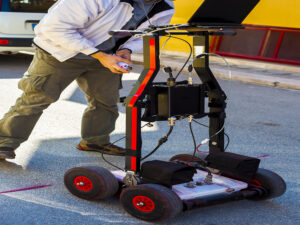
The two main methods for this task are GPR (Ground Penetrating Radar) and concrete X-ray. Let’s examine the differences.
Construction is a complicated operation. There are many roles on a construction site and different responsibilities for different crew members. One of the less well-known jobs on a construction crew is the person responsible for concrete scanning. Concrete scanning is an important task that needs to be done before any concrete cutting or drilling can be done safely. Concrete scanning is the process of examining what is embedded in or hidden under or behind concrete. The two main methods for this task are GPR (ground Penetrating Radar) and concrete X-ray. Let’s examine the differences.
What IS GPR?
GPR or Ground Penetrating Radar is a technology that uses radar, microwave energy that is sent out and then received back when it bounces off of underground or embedded material. GPR requires a skilled technician to operate and interpret the scan results, however the amount of information about what is hidden, where it is hidden, and the material is impressive. GPR can even distinguish the underground void of a tunnel that has backfill behind it.
What Is Concrete X-Ray?
Concrete X-ray processes are very similar to the x-ray process you undergo when you think you may have broken a bone or you need dental work. The technology uses radiation that passes through some material and is stopped or bounced back by other material. Once the radiation goes all the way through, the x-ray “image” that appears on the film shows the differences in material. Not all concrete x-rays use actual film – they can also be digital these days. The resulting image does need to be interpreted by a professional.
Which Is Better?
Both tools are incredibly important to the industry. Concrete x-ray does have some health concerns, because it uses radiation, while GPR does not. GPR is also very quiet and provides a clearer, more detailed view of the embedded objects. Concrete X-ray also tends to be more expensive, even though GPR requires a more skilled technician. GPR also is faster, providing real-time results that you can use right away. And while concrete x-ray can only scan one side of the object, GPR can give a 3-d view. Overall, GPR tends to be the more common choice because of the many benefits it provides, coupled with the fact that it is often available at a fairer price point.
Concrete Visions Will Get The Job Done Right
Concrete Visions has been working with clients for over 25 years. Our G&M Services installers are certified with the industry’s major firestop product manufacturers. As part of our firestop service, we can assess abnormal field conditions and, with the manufacturer’s technical support assistance, provide engineering judgments in a timely fashion to comply with contract specifications. Our Field Mechanics undergo ongoing training, including mandatory monthly safety meetings, weekly Toolbox Talks where safety and equipment information is shred, and trainings on safe work standards and safety best practices.
